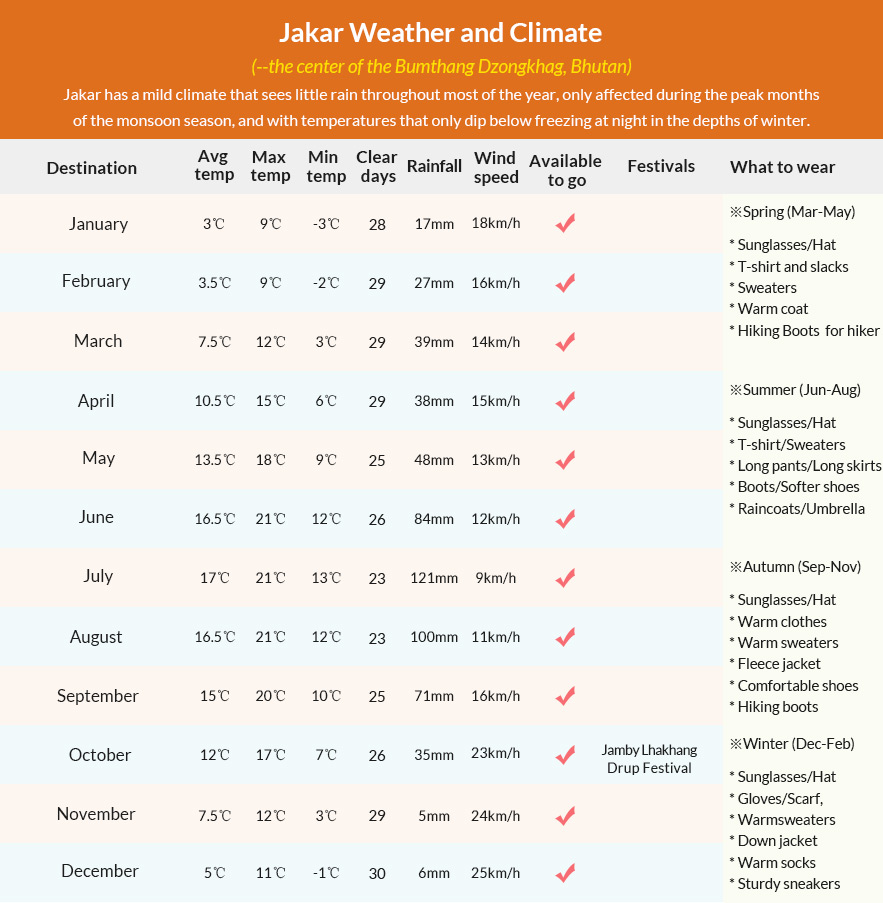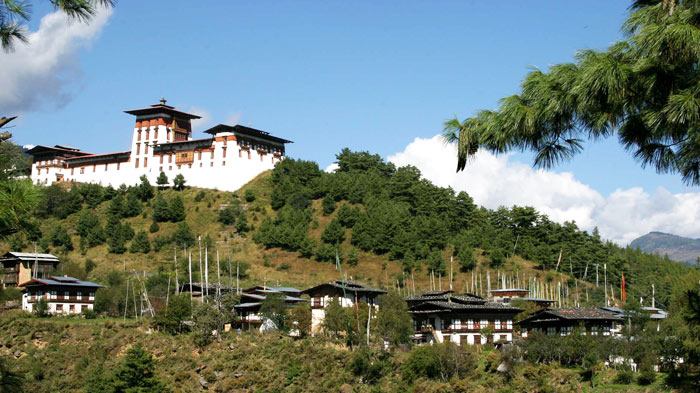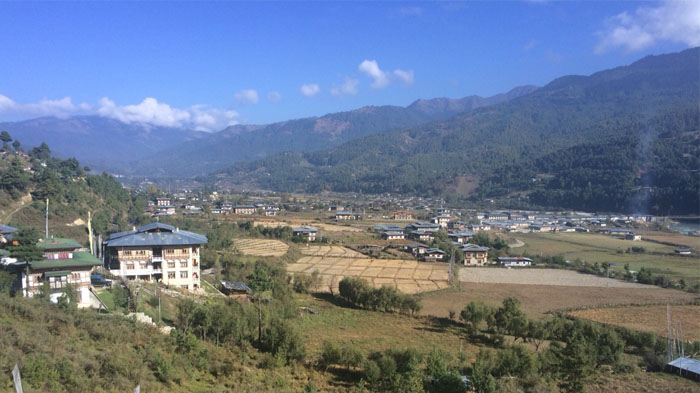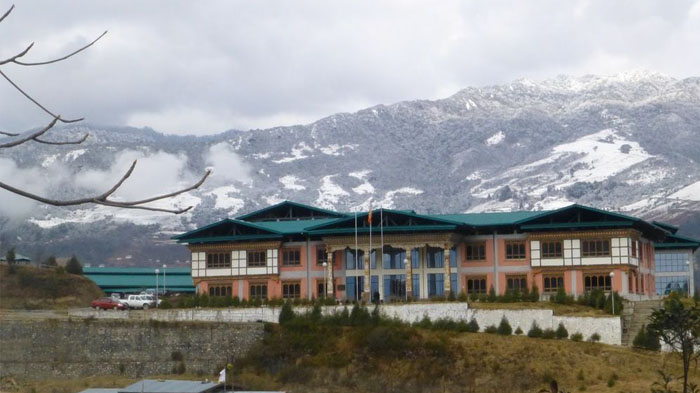
Weather and Climate of Jakar
Bhutan’s weather is unlike that of most Himalayan countries, with milder climates and a wider range of climate zones from north to south. In the north of the country the high mountains make the climate one of a typical alpine area, while in the south; the climate is more akin to the tropical and sub-tropical climes of the lowlands of northeast India, which lies along the southern border. Hot and humid, the southern areas see little cold weather, while in the north; the cooler climate means that it can often dip below freezing at night.
In the area around Jakar, in the Bumthang Dzongkhag, the weather is milder than in the south, but warmer than in the far north, lying as it does in the central region of the country. A long narrow valley area, Jakar has a mild climate that sees little rain throughout most of the year, only affected during the peak months of the monsoon season, and with temperatures that only dip below freezing at night in the depths of winter.
What is Jakar weather and climate by month?
Jakar Weather Guide
 Jakar Weather
Jakar Weather
Spring (March - May)
Average daytime temperature: 16°C
Average nighttime temperature: 6°C
Average wind speed: 15km/h
Average precipitation/month: 40mm
Clear days/month: 25
As March rolls in and spring starts to get underway, the weather warms up a little, with daytime highs of up to 9°C and lows of around 2°C at night. You can see up to around 40mm of rain in the month, but with around 26 clear days, there is little to affect a tour on the region.
 The clear and blue sky of Jakar in spring with greener trees.
The clear and blue sky of Jakar in spring with greener trees.
As April comes around, temperatures are really starting to pick up, with highs of up to 18°C and lows at night of only six degrees. However, there can be a little more rain in April, with around 42mm falling in the 4-5 rainy days through the month.
May is the last of the spring months, and sees a huge increase in temperatures, as well as in rainfall. Highs of up to 21°C can be seen in May, with nightly temperatures only getting down to around 10°C. May can expect to see around 57mm of rainfall, and you will find only around 20 days of sunshine in the month, on average.
Summer (June - August)
Average daytime temperature: 21°C
Average nighttime temperature: 12°C
Average wind speed: 18km/h
Average precipitation/month: 104mm
Clear days/month: 23
June sees the start of the real monsoon season, but with lower rainfall still, reaching only to around 294mm over the month, with about 15 clear days. Temperatures can reach up as high as 22°C, and are humid and sticky, with lows of only 13°C at night, making the night comfortable and easy to sleep in.
 The majestic Jakar Dzong with typical Bhutanese houses.
The majestic Jakar Dzong with typical Bhutanese houses.
July is the wettest and hottest month of the year in Jakar, with high temperatures that can reach up to around 23°C, and nighttime lows of only around 14°C, making it a warm and sticky month with high humidity throughout. Rainfall can be seen in around 23 days of the month, with around 320mm falling throughout July.
As August begins, the rains start to lessen, and you can see more than 12 clear days with only around 250mm of rain falling through the month. August temperatures are also dropping, with highs of up to 21°C, with the nightly low temperatures hitting as high as 13.3°C. Humidity is still high, though, and the month can be damp and sticky.
Autumn (September - November)
Average daytime temperature: 19°C
Average nighttime temperature: 10°C
Average wind speed: 16km/h
Average precipitation/month: 31mm
Clear days/month: 27
September is the last of the monsoon season, and the rains are reducing rapidly, ready for the drier autumn period. Rainfall drops to only around 118mm for the entire month, with more than 15 clear days. High temperatures of only around 20°C can be seen, with lows of around 11°C at night making it more pleasant and less sticky.
 A bird’s view of the beautiful Jakar in autumn
A bird’s view of the beautiful Jakar in autumn
October is the real start of the autumn season, with low temperatures dropping to around 6°C at night, and daily highs only getting up to around 18°C during the daytime. Rainfall has dropped dramatically, with only around 66mm throughout the month and as many as 23-25 clear days throughout the month.
November is the tail-end of the autumn season in Jakar, and the leaves begin to fall as the temperatures drop to around just 15°C during the daytime. Nights are starting to get colder as well, with temperatures that can get to around freezing or just 1°C. Rainfall however is minimal with only around 11mm of rain for the month and almost all clear days.
Winter (December - February)
Average daytime temperature: 10°C
Average nighttime temperature: -2°C
Average wind speed: 19km/h
Average precipitation/month: 9mm
Clear days/month: 29
December sees the start of winter in Jakar, and as the low season begins the temperatures at night can drop to well below freezing, reaching lows of around -3°C. Daytime highs can reach up to 12°C, making the days warm enough for Bhutan travel, and with only around 3mm of rain in the entire month; every day is a clear and bright day in this dry and arid month.
 The snow covered mountainson Jakar in January.
The snow covered mountainson Jakar in January.
January is the coldest month of the year, on average, with the average temperature getting down to around 3.7°C. Highs can be seen of up to 11°C during the day, with nighttime lows of around -4°C. There is very little rain in January, with only around 6mm throughout the month, and around 29 clear days.
February sees a little warmer weather, though the lows at night can still drop to around -1°C. Daytime temperatures can reach up to 13°C in February, with only around 11mm of rain and only averaging one rainy day for the month. Snow is rare in Jakar, even in the coldest parts of the year.
When is the best time to visit Jakar?
Jakar has good average temperatures for most of the year, with lower temperatures only in the winter months from December to February. However, even in the winter, it is possible to visit this stunningly beautiful valley. Spring and autumn are the best times to visit, as there is lower rainfall and clear skies for viewing the mountains, as well as warm temperatures that make the seasons ideal for trekking. - Check the Bhutan Trekking Season: when is the best time to trek Bhutan?
 Trekking enjoyably in the old-growth forest in fine weather
Trekking enjoyably in the old-growth forest in fine weather
Summer is a wet time of year in Jakar, though not as wet as some of the areas in central Bhutan in the summer months. Most of the rain falls from July to August, with high humidity and high temperatures that are on a par with most of the rest of the central region. Winter, on the other hand, is not as cold as much of the area in the central and western areas of Bhutan, thanks to the deep valley in which the city lies. This allows for a better winter tour than in some places, with plenty of opportunity to trek in the area.Is Jakar weather in Jul. and Aug. too rainy or Dec. and Jan. too cold to visit?
What is the monsoon season like from late June to middle Sep. in Jakar?
While the monsoon season in Jakar can be pretty wet, it is light in comparison with many of the areas of central Bhutan, and rarely sees much more than 300mm of rain at most, even in the wettest month of the year. Humidity is high, though, making the air sticky and damp, which can be detrimental to trekking in the region. However, with most of the rainfall coming in late in the day, with only a few exceptions, much of the monsoon season is open for tours and sightseeing, if not for trekking.
Is it possible to visit Jakar during the monsoon season?
It is easily possible to travel in Jakar during the monsoon season, as there is not as much rainfall as in Paro and Thimphu to the west, and nowhere near as high as the rainfall in Punakha in the monsoon months. Jakar is the ideal place to get away from the major cities and learn a little more about the outlying areas and the remote ethnic peoples of the area, and in the summer months, when there is less chance for trekking, sightseeing and cultural tours are the best option.
What is the winter like from December to February in Jakar?
Jakar actually sees what can be called an average winter for the region, as the temperatures are only below freezing at night in the months of January and February, and the daytimes can see temperatures getting up to as high as 11 or 12 degrees. With this warmer winter and little chance of rain or snow in the valley, Jakar is one of the better places to visit in winter, mostly for the comfortable climate and the ability for trekking in winter.
Besides the city tour what else we can do in Jakar winter?
Jakar is renowned as the primary locations in Bhutan for winter trekking, and has a number of treks that can be completed in the winter months. One of the most popular is the Bumthang Cultural Trek, which takes you along the valleys surrounding Jakar and into the hinterlands to visit some of the local villages and the ethnic cultures of the region over a three to five day period. Another great trek in Bumthang in the winter months is the Owl trek, a light three-day trek that takes you through lush forests of hemlock and rhododendron, as well as up to the pass at Dagala, the Dagala Thousand lakes trek though most of the trek lies at altitudes of below 3,000 meters. This makes it more possible in winter as there is little chance of snow in the area at these altitudes.
Conclusion
Jakar is the center of the Bumthang Dzongkhag, and the administrative seat of the district. Also sometimes known as Bumthang itself, Jakar is one of the most popular places to visit in central Bhutan, as the weather is relatively mild and the trekking is outstanding, with lush forests and excellent views of the higher mountains to the north. One of the great places that can be visited all year round, Jakar is a fair drive from Thimphu and Paro, but is worth the time taken to get there for the unique ethnic cultures that inhabit the region.

Kham Sang is responsible and honest with more than six years of guide experience in Tibet.She has strong interpersonal skills and can communicate effectively with tourists.


.jpg)



0 Comment ON "Weather and Climate of Jakar"